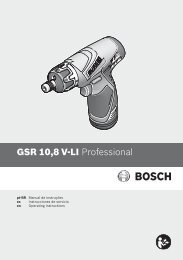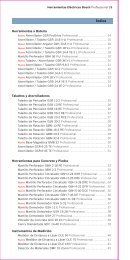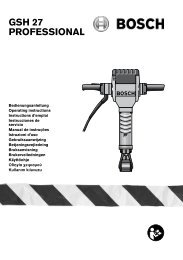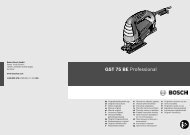GST 85 PBE PROFESSIONAL
GST 85 PBE PROFESSIONAL
GST 85 PBE PROFESSIONAL
Create successful ePaper yourself
Turn your PDF publications into a flip-book with our unique Google optimized e-Paper software.
General Power Tool Safety Warnings<br />
WARNING<br />
Read all safety warnings and all 3) Personal safety<br />
instructions. Failure to follow the a) Stay alert, watch what you are doing and<br />
warnings and instructions may result in electric use common sense when operating a<br />
shock, fire and/or serious injury.<br />
power tool. Do not use a power tool while<br />
Save all warnings and instructions for future you are tired or under the influence of<br />
reference.<br />
drugs, alcohol or medication. A moment of<br />
The term “power tool” in the warnings refers to inattention while operating power tools may<br />
your mains-operated (corded) power tool or battery-operated<br />
(cordless) power tool.<br />
result in serious personal injury.<br />
b) Use personal protective equipment. Always<br />
wear eye protection. Protective<br />
1) Work area safety<br />
a) Keep work area clean and well lit. Cluttered equipment such as dust mask, non-skid safety<br />
shoes, hard hat, or hearing protection used<br />
or dark areas invite accidents.<br />
for appropriate conditions will reduce personal<br />
injuries.<br />
b) Do not operate power tools in explosive<br />
atmospheres, such as in the presence of<br />
flammable liquids, gases or dust. Power c) Prevent unintentional starting. Ensure the<br />
tools create sparks which may ignite the dust switch is in the off-position before connecting<br />
to power source and/or battery<br />
or fumes.<br />
pack, picking up or carrying the tool. Carrying<br />
power tools with your finger on the<br />
c) Keep children and bystanders away while<br />
operating a power tool. Distractions can<br />
switch or energising power tools that have the<br />
cause you to lose control.<br />
switch on invites accidents.<br />
2) Electrical safety<br />
d) Remove any adjusting key or wrench before<br />
turning the power tool on. A wrench or<br />
a) Power tool plugs must match the outlet.<br />
Never modify the plug in any way. Do not a key left attached to a rotating part of the<br />
use any adapter plugs with earthed power tool may result in personal injury.<br />
(grounded) power tools. Unmodified plugs e) Do not overreach. Keep proper footing and<br />
and matching outlets will reduce risk of electric<br />
shock.<br />
trol of the power tool in unexpected situations.<br />
balance at all times. This enables better con-<br />
b) Avoid body contact with earthed or f) Dress properly. Do not wear loose clothing<br />
or jewellery. Keep your hair, clothing<br />
grounded surfaces, such as pipes, radiators,<br />
ranges and refrigerators. There is an and gloves away from moving parts.<br />
increased risk of electric shock if your body is Loose clothes, jewellery or long hair can be<br />
earthed or grounded.<br />
caught in moving parts.<br />
c) Do not expose power tools to rain or wet g) If devices are provided for the connection<br />
conditions. Water entering a power tool will of dust extraction and collection facilities,<br />
increase the risk of electric shock.<br />
ensure these are connected and properly<br />
d) Do not abuse the cord. Never use the cord used. Use of dust collection can reduce dustrelated<br />
hazards.<br />
for carrying, pulling or unplugging the power<br />
tool. Keep cord away from heat, oil, sharp<br />
4) Power tool use and care<br />
edges or moving parts. Damaged or entangled<br />
cords increase the risk of electric shock. a) Do not force the power tool. Use the correct<br />
power tool for your application. The<br />
e) When operating a power tool outdoors,<br />
correct power tool will do the job better and<br />
use an extension cord suitable for outdoor<br />
use. Use of a cord suitable for outdoor<br />
safer at the rate for which it was designed.<br />
use reduces the risk of electric shock.<br />
b) Do not use the power tool if the switch<br />
does not turn it on and off. Any power tool<br />
f) If operating a power tool in a damp location<br />
is unavoidable, use a residual current<br />
that cannot be controlled with the switch is<br />
dangerous and must be repaired.<br />
device (RCD) protected supply. Use of an<br />
RCD reduces the risk of electric shock.<br />
6 • 1 619 P01 997 • TMS • 23.03.06<br />
English - 1








